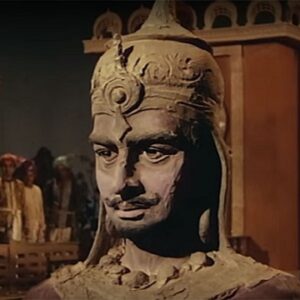Ajatasatru was the Haryanka dynasty of the Magadha kingdom’s powerful and forceful emperor. He aspired to be the supreme ruler and ruler over all of North India. “Such was his desperation to assume the throne and dominate the empire,” Buddhist sources say, “that he imprisoned his father, Bimbisara, and had him assassinated.” He invaded Vaisali with the goal of expanding his empire, and after a 16-year conflict with its monarch, Chetaka, he was successful in conquering the republic. He next turned his attention to the minor kingdoms of Kasi and Kosala. He invaded 36 more kingdoms and republican states around Magadha, eventually extending Magadha’s power across North India, from present-day Haryana and Himachal Pradesh in the west to Bihar and West Bengal in the east, in a desperate attempt to expand his empire. While he is considered to be a follower of both Jainism and Buddhism, records show that he was a Jain devotee due to his multiple encounters with Mahavira rather than a single encounter with Buddha.
Childhood and Adolescence
According to Jainism and Buddhist sources, Ajatasatru, also known as Kunika, was born to King Bimbisara, the ruler of the Magadha empire, and Queen Chelna or Kosala Devi, however, both traditions referred to the queen as Vaidehi.
After his father’s death in 492 BC, he ascended the king. According to Jain tradition, he committed himself, although Buddhist tradition claims that Ajatasatru assassinated him in order to take over the Magadha Empire.
Reign & Accession
Soon after assuming power as king of Magadha, he embarked on a conquest-based strategy to expand his empire, going north and west after his father had conquered Anga in the east.
A quarrel between Sechanaka and his two brothers, Halla and Vihalla, over the ownership of Sechanaka’s elephant and valuable gems led to the Battle of Vaisali when the two retreated to seek sanctuary from their maternal grandfather, Chetak.
After being refused permission to surrender the two brothers, he enlisted the help of his half-brothers, the Kalkumaras, to assault the impregnable Vaisali, while Chetak was backed up by his friends, the 9 Mallas, 9 Lichhvis, and 18 monarchs of Kasi-Kosala.
Chetak, a devout follower of Lord Mahavira, promised not to shoot more than one arrow every day in battle, resulting in the death of one Kalkumara per day.
When he realized his defeat, he prayed to many Indras for assistance, and they granted him the ‘Mahasilakantaka,’ a device that discharged enormous stones, and the ‘Ratha-masala,’ a divine chariot with swinging blades on both sides.
He was able to route Chetak with the two war devices, and he took refuge within the fortified walls of Vaisali, which were difficult to breach. Through a ploy, he beat him and conquered Vaisali.
He despatched his minister, Vassakara, to Vaisali to foment jealousy among the Lichchhavis and shatter their unity, as per Buddhist tradition. After that, he assaulted the region and, after 16 years of struggle, conquered it.
Both Jainism and Buddhism claim he was a disciple of their respective faiths, while evidence suggests he met Mahavira numerous times, whereas he only met Buddha once.
According to the facts and data gathered by numerous experts, there is no evidence that he accepted Buddhism; rather, he was a devout Mahavira disciple.
After Buddha’s death, he sought a share of his relics and built a massive stupa on top of them, in addition to restoring 18 Buddhist monasteries and encouraging the construction of further stupas throughout his capital.
Battles of Importance
He launched a war on the Kosala monarch, Presenajit, to settle the dispute over the town of Kasi, and conquered him. Kasi was not only joined the Magadha realm, but he also married Vajira, the king’s daughter.
He used two magical gadgets supplied by the Indras to beat his maternal grandpa, Chetak, at the Battle of Vaisali and thereafter captured Vaisali.
Ajatasatru Achievements
He built a formidable Magadha Empire by conquering 36 kingdoms and republican states, including modern-day Haryana, Delhi, Uttar Pradesh, Himachal Pradesh, Bihar, West Bengal, Chhattisgarh, Jharkhand, and Madhya Pradesh.
To bolster Magadha’s security, he built Patali grama, which ultimately became Pataliputra, a new fort on the banks of the Ganges (modern-day Patna).
Soon after Buddha’s death, Ajatsatru convened the First Buddhist Council in Rajgir, which was held in a conference hall he built outside the Sattaparnaguha Cave or Sattapani Caves, cementing his place in Buddhist history.
Personal History and Legacy
According to Jain sources, he had eight wives, the most important of whom were Padmavati, Dharini, and Subhadra, although Buddhist legends claim he had 500 wives, the most important of whom was Princess Vajira.
He had a son, Udayabhadda or Udayabhadra, according to both Buddhist and Jain traditions.
In 461 BC, his son killed him in order to take over the kingdom, putting an end to Ajatasatru’s 32-year rule.
Estimated net worth
Ajatshatru Singh has an estimated net worth of $ USD 7 million and earns a living as a politician. We don’t have adequate information about Ajatshatru Singh’s cars or lifestyle. These details will be updated as soon as possible.


